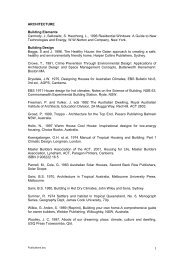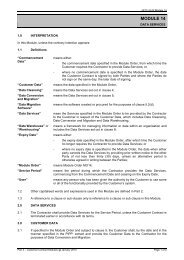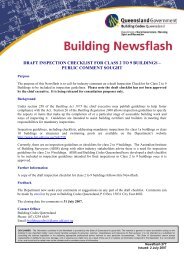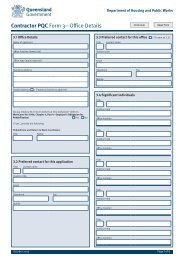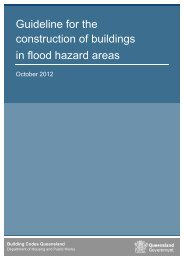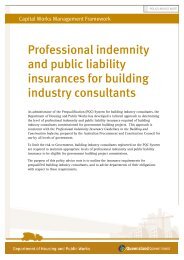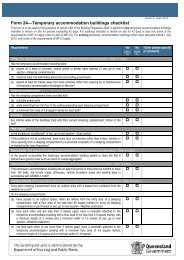Guidelines for pool owners and property agents - Department of ...
Guidelines for pool owners and property agents - Department of ...
Guidelines for pool owners and property agents - Department of ...
You also want an ePaper? Increase the reach of your titles
YUMPU automatically turns print PDFs into web optimized ePapers that Google loves.
<strong>Guidelines</strong> <strong>for</strong> <strong>pool</strong> <strong>owners</strong> <strong>and</strong> <strong>property</strong> <strong>agents</strong> Page 13 <strong>of</strong> 56<br />
5.2 Dividing fences<br />
Often boundary fences <strong>for</strong>m part <strong>of</strong> the <strong>pool</strong> barrier. In these cases the <strong>pool</strong> safety st<strong>and</strong>ard still<br />
applies to the part <strong>of</strong> the boundary fence being used as part <strong>of</strong> the <strong>pool</strong> barrier.<br />
The boundary fence must be a minimum <strong>of</strong> 1200 millimetres high <strong>and</strong> have a complying NCZ.<br />
However, it is important to note that if the fence is less than 1800 millimetres in height, the NCZ<br />
must be on the outside <strong>of</strong> the fence (neighbour’s side). A <strong>pool</strong> owner is unable to control the<br />
actions <strong>of</strong> a neighbour <strong>and</strong> there<strong>for</strong>e has no control <strong>of</strong> the NCZ. If the fence is 1800 millimetres or<br />
higher, the NCZ can be on the inside. Pool <strong>owners</strong> should consider whether they are able to<br />
control the area outside <strong>of</strong> the <strong>pool</strong> fence be<strong>for</strong>e deciding on a fence height that requires the NCZ<br />
on the outside <strong>of</strong> the fence.<br />
The wall <strong>of</strong> a building on a common boundary may also be used as part <strong>of</strong> a <strong>pool</strong> barrier if it<br />
complies with the <strong>pool</strong> safety st<strong>and</strong>ard. The <strong>pool</strong> owner is prohibited from altering the building<br />
without the owner’s consent. Where any part <strong>of</strong> the wall does not meet the requirements <strong>of</strong> the<br />
<strong>pool</strong> safety st<strong>and</strong>ard, the <strong>pool</strong> owner may need to construct a separate barrier inside their <strong>property</strong><br />
to comply with the st<strong>and</strong>ard.<br />
Part 2A <strong>of</strong> Chapter 8 <strong>of</strong> the BA provides the regime <strong>for</strong> <strong>pool</strong> <strong>owners</strong> who propose to use or<br />
construct a fence on a common boundary as a <strong>pool</strong> barrier. This should be read in conjunction with<br />
the Neighbourhood Disputes Resolution Act 2011.<br />
Pool <strong>owners</strong> are encouraged to discuss the fencing work with their neighbour be<strong>for</strong>e making any<br />
decisions. If a <strong>pool</strong> owner decides to do the fencing work without obtaining an agreement from the<br />
neighbour, the <strong>pool</strong> owner must give the neighbour a notice about proposed work at least 14 days<br />
prior to undertaking any work. This notice (Form 39 − Notice <strong>of</strong> proposed fencing work <strong>for</strong> a <strong>pool</strong><br />
barrier) will include in<strong>for</strong>mation on the type <strong>of</strong> fence proposed <strong>and</strong> the materials that will be used.<br />
The proposed <strong>pool</strong> barrier must be consistent with the existing fence e.g. similar materials <strong>and</strong><br />
colours, unless this would prevent the fence from complying with the <strong>pool</strong> safety st<strong>and</strong>ard.<br />
Details about the costs associated with the fencing work should also be provided to the neighbour<br />
on the Form 39. The costs associated with constructing, altering, repairing, replacing <strong>and</strong><br />
maintaining a regulated <strong>pool</strong>’s fence to make it compliant with the <strong>pool</strong> safety st<strong>and</strong>ard, are to be<br />
borne in full by the owner <strong>of</strong> the l<strong>and</strong> on which the <strong>pool</strong> is situated.<br />
If there are <strong>pool</strong>s on both sides <strong>of</strong> the fence <strong>and</strong> the work or part <strong>of</strong> the work is done to allow both<br />
parties comply, the cost is borne equally by the <strong>pool</strong> <strong>owners</strong>.<br />
However, if one <strong>pool</strong> owner requires fencing work <strong>and</strong> the other <strong>pool</strong> owner does not, the costs are<br />
borne solely by the <strong>pool</strong> owner requiring the changes. Details about the costs associated with the<br />
fencing work should also be provided to the neighbour on the Form 39.<br />
6 Compliance considerations<br />
6.1 Fencing, gates <strong>and</strong> latches<br />
The minimum height <strong>for</strong> a <strong>pool</strong> fence is 1200 millimetres, measured from ground level (refer to<br />
Appendix A − Figure 1). The distance between the bottom <strong>of</strong> the <strong>pool</strong> barrier <strong>and</strong> the ground<br />
must be less than 100 millimetres <strong>and</strong> the distance between any vertical members such as palings,<br />
rods or wires must also be less than 100 millimetres.<br />
Building Codes Queensl<strong>and</strong>



